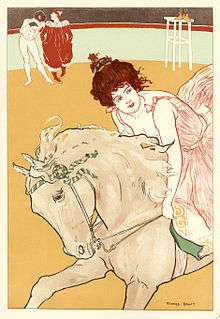Richard Ranft
Richard Albin Ranft (18 July 1862 – 13 June 1931) was a Swiss post-impressionist portrait and landscapes painter, engraver, illustrator and poster artist.
Richard Ranft | |
|---|---|
| Born | 18 July 1862 |
| Died | 13 June 1931 Chantilly, France |
| Nationality | Swiss |
| Known for | Painting |
| Movement | Post-Impressionism |
Biography

Ranft was born in Plainpalais and began studying painting and drawing in Geneva, under the direction of Eugene Etienne Sordet (1836-1915), who taught him the art of landscape painting. He then moved to Paris, where he attended the workshops of Gustave Courbet and Augustin-Alexandre Dumont, a sculptor who taught him engraving. Ranft then created many lithographed plates, including posters and etchings, while continuing with landscape painting.
In Paris he was elected a Full Member of the Société Nationale des Beaux-Arts, in whose Salons he exhibited regularly as well as in the Société des Artistes Indépendants.
Ranft died in June 1931. A few weeks later, Gustave Kahn paid tribute in the Mercure de France, when a retrospective of the painter was organized at the Autumn Salon.[1]
Works
Ranft illustrated several books, executed 85 original etchings in colour, 26 in black, several monotypes, one lithograph and sixteen etchings reproducing paintings by various artists, including Turner, Whistler and Reynolds. He exhibited at the First Symbolist Salon of the Rose+Croix in 1892. He was considered in England to be the best interpreter of J. M. W. Turner.[2]
Between 1892 and 1913 he was the author of several illustrations for books, and two novels, Miss Orchair (1892) and L'Illustre Famille (1913).
Further reading
- Allgemeines Lexikon der bildenden Künstler von der Antike bis zur Gegenwart, 28. Band, Leipzig, S. 6.
- O. Glaser, die Graphik der Neuzeit, Berlin, 1923, S. 381 ff.
- Die graphischen Künste, 26. Band, Vienna, 1904, S. 43-48, daselbst 5 Abbildungen, eine davon farbig.
- Allgemeines Lexikon der Bildenden Künstler des XX. Jahrhunderts, Band 4, Leipzig 1958, S. 17.
- Edouard Joseph, Dictionaire biographique des Artistes contemporains 1910-1930, Band III, Paris 1934, S. 177-178.
- Janine Bailly-Herzberg: Dictionnaire de l’Estampe en France 1830-1950
References
- Mercure de France, 1931, page 456.
- Guillaume Apollinaire. On Art (Documents of 20th Century Art). Thames & Hudson Ltd, 1972, pages 101-102.
External links
| Wikimedia Commons has media related to: |
- Color engraverRichard Ranft in CDOA, Ministry of Culture (France)
- "Richard Ranft". SIKART Lexicon on art in Switzerland.
- « Sur la plage. À l'ombrelle », monotype preserved at the Centre Pompidou